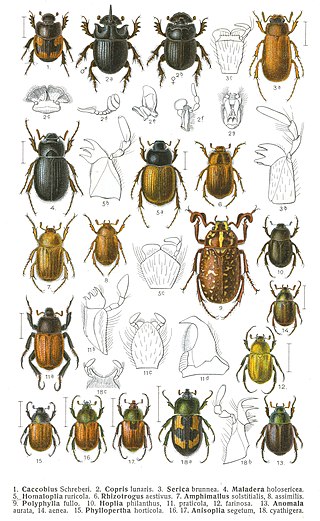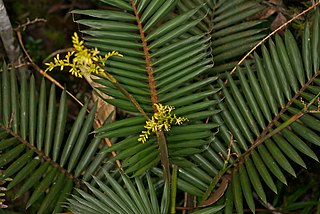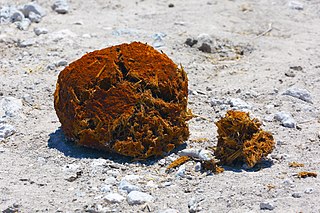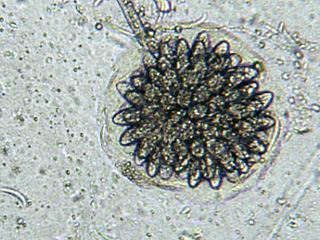
Caenorhabditis elegans is a free-living transparent nematode about 1 mm in length that lives in temperate soil environments. It is the type species of its genus. The name is a blend of the Greek caeno- (recent), rhabditis (rod-like) and Latin elegans (elegant). In 1900, Maupas initially named it Rhabditides elegans. Osche placed it in the subgenus Caenorhabditis in 1952, and in 1955, Dougherty raised Caenorhabditis to the status of genus.

The family Scarabaeidae, as currently defined, consists of over 35,000 species of beetles worldwide; they are often called scarabs or scarab beetles. The classification of this family has undergone significant change in recent years. Several groups formerly treated as subfamilies have been elevated to family rank, and some reduced to lower ranks. The subfamilies listed in this article are in accordance with those in Catalog of Life (2023).

Dung beetles are beetles that feed on feces. Some species of dung beetles can bury dung 250 times their own mass in one night.

Calamus is a genus of flowering plants in the palm family Arecaceae that is one of several genera known as rattan palms. There are an estimated 400 species in this genus, all native to tropical and subtropical Asia, Africa, and Australia.

Cow dung, also known as cow pats, cow pies, cow poop or cow manure, is the waste product (faeces) of bovine animal species. These species include domestic cattle ("cows"), bison ("buffalo"), yak, and water buffalo. Cow dung is the undigested residue of plant matter which has passed through the animal's gut. The resultant faecal matter is rich in minerals. Color ranges from greenish to blackish, often darkening soon after exposure to air.
Dauer describes an alternative developmental stage of nematode worms, particularly rhabditids including Caenorhabditis elegans, whereby the larva goes into a type of stasis and can survive harsh conditions. Since the entrance of the dauer stage is dependent on environmental cues, it represents a classic and well studied example of polyphenism. The dauer state is given other names in the various types of nematodes such as ‘diapause’ or ‘hypobiosis’, but since the C. elegans nematode has become the most studied nematode, the term ‘dauer stage’ or 'dauer larvae' is becoming universally recognised when referring to this state in other free-living nematodes. The dauer stage is also considered to be equivalent to the infective stage of parasitic nematode larvae.

The scarab beetle subfamily Scarabaeinae consists of species collectively called true dung beetles. Most of the beetles of this subfamily feed exclusively on dung. However, some may feed on decomposing matter including carrion, decaying fruits and fungi. Dung beetles can be placed into three structural guilds based on their method of dung processing namely rollers (telecoprids), dwellers (endocoprids) and tunnelers (paracoprids). Dung removal and burial by dung beetles result in ecological benefits such as soil aeration and fertilization; improved nutrient cycling and uptake by plants, increase in Pasture quality, biological control of pest flies and intestinal parasites and secondary seed dispersal. Well-known members include the genera Scarabaeus and Sisyphus, and Phanaeus vindex.

Licuala is a genus of palms, in the tribe Trachycarpeae, commonly found in tropical forests of southern China, Southeast Asia, the Himalayas, New Guinea and the western Pacific Ocean islands.

Conocybe is a genus of mushrooms with Conocybe tenera as the type species and at least 243 other species. There are at least 50 different species in North America.
Hyphomycetes are a form classification of fungi, part of what has often been referred to as fungi imperfecti, Deuteromycota, or anamorphic fungi. Hyphomycetes lack closed fruit bodies, and are often referred to as moulds. Most hyphomycetes are now assigned to the Ascomycota, on the basis of genetic connections made by life-cycle studies or by phylogenetic analysis of DNA sequences; many remain unassigned phylogenetically.

Nematophagous fungi are carnivorous fungi specialized in trapping and digesting nematodes. Around 160 species are known. Species exist that live inside the nematodes from the beginning and others that catch them, mostly with glue traps or in rings, some of which constrict on contact. Some species possess both types of traps. Another technique is to stun the nematodes using toxins, a method employed by Coprinus comatus, Stropharia rugosoannulata, and the family Pleurotaceae. The habit of feeding on nematodes has arisen many times among fungi, as is demonstrated by the fact that nematophagous species are found in all major fungal groups. Nematophagous fungi can be useful in controlling those nematodes that eat crops. Purpureocillium, for example, can be used as a bio-nematicide.

The Orbiliaceae are a family of saprobic sac fungi. It is the only family in the monotypic class Orbiliomycetes and the monotypic order Orbiliales. The family was first described by John Axel Nannfeldt in 1932 and now contains 288 species in 12 genera. Members of this family have a widespread distribution, but are more prevalent in temperate regions. Some species in the Orbiliaceae are carnivorous fungi, and have evolved a number of specialized mechanisms to trap nematodes.

Aphodius is a genus of beetles in the family Scarabaeidae. In most species both the adults and larvae are coprophagous although some species have herbivorous or saprophagous larvae. Aphodius species typically dominate dung beetle communities in north temperate ecosystems. Most species are functionally classified as endocoprids, also known as dwellers, because the larvae live and feed within the dung pat itself.

Feces are the solid or semi-solid remains of food that was not digested in the small intestine, and has been broken down by bacteria in the large intestine. Feces contain a relatively small amount of metabolic waste products such as bacterially altered bilirubin, and dead epithelial cells from the lining of the gut.

Arthrobotrys is a genus of mitosporic fungi in the family Orbiliaceae. There are 71 species. They are predatory fungi that capture and feed on nematode worms. Rings that form on the hyphae constrict and entrap the worms, then hyphae grow into the worm and digest it.

Rhopalomyces elegans is a common species of zygomycete fungus, and the type species of the genus Rhopalomyces. Widely distributed, it is found in soil, rotting plant material, and animal dung. It is a facultative parasite of nematode eggs.

Arthrobotrys oligospora was discovered in Europe in 1850 by Georg Fresenius. A. oligospora is the model organism for interactions between fungi and nematodes. It is the most common nematode-capturing fungus, and most widespread nematode-trapping fungus in nature. It was the first species of fungi documented to actively capture nematodes.
Arthrobotrys dactyloides is a species of fungus in the family Orbiliaceae. It is nematophagous, forming loops of hypha to trap nematodes, on which it then feeds.
Birgit Ann-Marie Margareta Nordbring-Hertz, was a Swedish scientist at Lund University known for her work on the interactions between fungi and nematodes.
Arthrobotrys musiformis is a species of nematode catching fungi, genus Arthrobotrys. This, like other Arthrobotrys species, captures and feeds on nematodes. It is widespread, with its initial discovery being in Norfolk, Virginia. This species demonstrates promising anti-helminth potential, and is hypothesized to reduce the number of parasitic nematodes in plants and livestock as either a biocontrol or through isolating metabolites.













